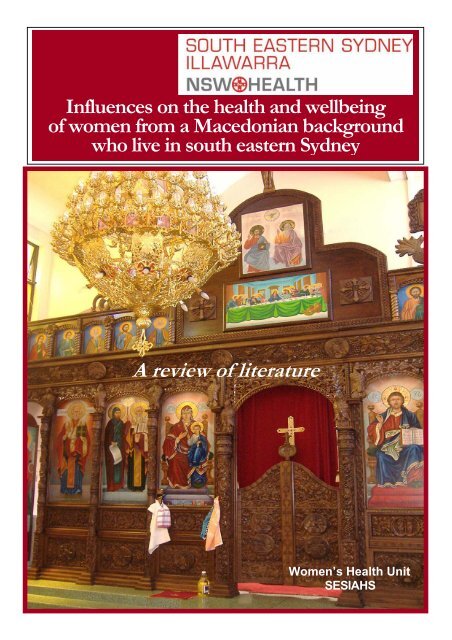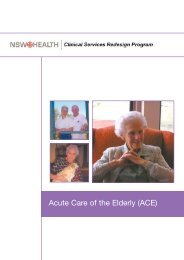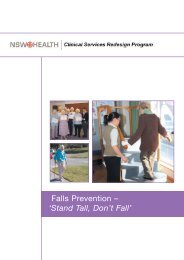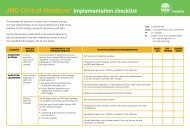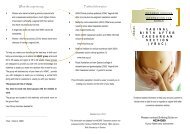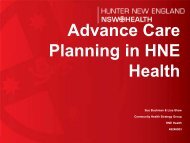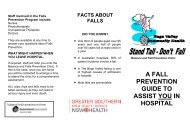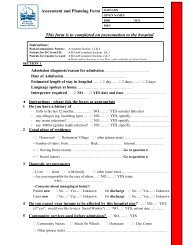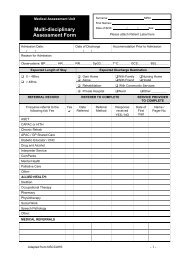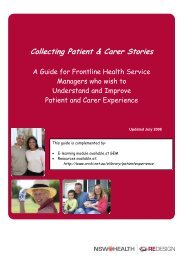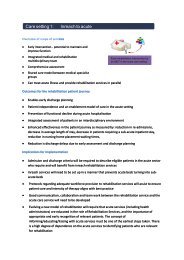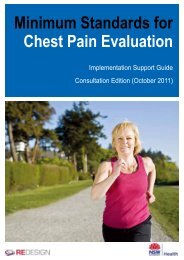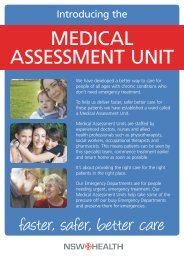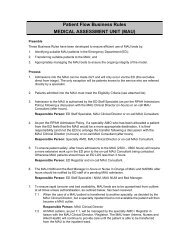A review of literature, 2006 ( pdf - 438 KB) - ARCHI
A review of literature, 2006 ( pdf - 438 KB) - ARCHI
A review of literature, 2006 ( pdf - 438 KB) - ARCHI
You also want an ePaper? Increase the reach of your titles
YUMPU automatically turns print PDFs into web optimized ePapers that Google loves.
Influences on the health and wellbeing<br />
<strong>of</strong> women from a Macedonian background<br />
who live in south eastern Sydney<br />
A <strong>review</strong> <strong>of</strong> <strong>literature</strong><br />
Women’s Health Unit<br />
SESIAHS
Macedonian Women’s Health Project<br />
Review <strong>of</strong> <strong>literature</strong><br />
___________________________________________________________________<br />
Acknowledgments<br />
The Macedonian Women’s Health Project team would like to thank Nada Tizzone,<br />
Valentina Angelovska, Gorjana Milosevski, Dushan Ristevski and Dr Lillijana<br />
Stojanovska-Petrovska for taking time to discuss the project as it was being<br />
developed and providing resources and suggestions for the <strong>literature</strong> <strong>review</strong>.<br />
Thanks to Mindy Xie (Clinical Services Policy and Planning Unit) and Seema Shariff<br />
(Multicultural Health Unit) for their contributions to the collection <strong>of</strong> data on the<br />
Macedonian community.<br />
Thanks must also be extended to Reverend Father Blaze Poposki for giving his<br />
permission for photographs to be taken <strong>of</strong> women’s <strong>of</strong>ferings for the health <strong>of</strong> loved<br />
ones at the front <strong>of</strong> Saints Kiril and Metodij Macedonian Orthodox church at<br />
Rosebery.<br />
Literature <strong>review</strong> prepared by Mara Tanevska, Claire Ferguson and Wilma Espinoza<br />
© Women’s Health Unit<br />
South Eastern Sydney and Illawarra Area Health Service
Macedonian Women’s Health Project<br />
Review <strong>of</strong> <strong>literature</strong><br />
___________________________________________________________________<br />
Contents<br />
Overview 1<br />
Introduction 2<br />
Purpose 3<br />
Method 3<br />
Background 4<br />
Macedonia 4<br />
History 4<br />
Identity 5<br />
Migration 5<br />
Religion 6<br />
Family 6<br />
Demographic pr<strong>of</strong>ile 7<br />
Macedonian population in south eastern Sydney and NSW 8<br />
Macedonian women in south eastern Sydney 9<br />
Cause <strong>of</strong> death and hospitalisation 13<br />
Use <strong>of</strong> other health services 14<br />
Factors influencing the health <strong>of</strong> women 16<br />
Historical influences 16<br />
Cultural influences 17<br />
Social influences 19<br />
Behavioural influences 22<br />
Conclusion 25<br />
References
Macedonian Women’s Health Project<br />
Review <strong>of</strong> <strong>literature</strong><br />
___________________________________________________________________<br />
Overview<br />
This <strong>literature</strong> <strong>review</strong> is the first phase <strong>of</strong> Macedonian Women’s Health Project<br />
initiated by the Women’s Health Unit (WHU) in late 2004. Macedonian women were<br />
selected as the focal point <strong>of</strong> this project as they have been identified as a group who<br />
may be disadvantaged in accessing mainstream health services.<br />
The <strong>review</strong> <strong>of</strong> <strong>literature</strong> is the first step in gaining an understanding <strong>of</strong> some <strong>of</strong> the<br />
many influences (both positive and negative) on the health and wellbeing <strong>of</strong><br />
Macedonian women in south eastern Sydney. Its contents will be combined with<br />
information gained from interviews and discussion groups with Macedonian women<br />
and consultations with those who work with the community to inform the priorities and<br />
strategies employed in the Macedonian Women’s Health Project in the future.<br />
The first section <strong>of</strong> the <strong>review</strong> provides some information on Macedonia, its history<br />
and culture to serve as a background and context for the influences on the health <strong>of</strong><br />
Macedonian women outlined later in the document. In the next section, a<br />
demographic pr<strong>of</strong>ile <strong>of</strong> Macedonian women in south eastern Sydney presents<br />
information on social factors such as English pr<strong>of</strong>iciency, education and occupation<br />
as well as data on causes <strong>of</strong> death and reasons for hospitalisation. The body <strong>of</strong> the<br />
<strong>review</strong> collates the limited published information available on historical, cultural,<br />
social and behavioural factors that may influence the health <strong>of</strong> Macedonian women in<br />
south eastern Sydney.<br />
Although it is difficult to measure or document the precise impact, it is clear that<br />
Macedonia’s turbulent history and the experience <strong>of</strong> migrating to Australia are potent<br />
influences on the lives <strong>of</strong> women in the Macedonian community in south eastern<br />
Sydney. A background <strong>of</strong> conflict, oppression and persecution has damaged and<br />
continues to influence their identity as Macedonians. The many roles <strong>of</strong> Macedonian<br />
women in the family and community and their beliefs and practices relating to their<br />
health and well being are also clearly influenced by a blend <strong>of</strong> the traditional<br />
Macedonian culture – especially its religion – with the modern Australian (or more<br />
specifically south eastern Sydney) culture in which they live.<br />
The <strong>review</strong> <strong>of</strong> <strong>literature</strong> provides an overview <strong>of</strong> some <strong>of</strong> factors that may affect the<br />
health <strong>of</strong> Macedonian women but is limited to summarising what has been published.<br />
It also raises several important questions relating to the complex interaction <strong>of</strong><br />
influences on women’s health that may be explored in more detail in the next phase<br />
<strong>of</strong> the Macedonian Women’s Health Project in consultations with women and<br />
community workers.<br />
- 1 -
Macedonian Women’s Health Project<br />
Review <strong>of</strong> <strong>literature</strong><br />
___________________________________________________________________<br />
Introduction<br />
Late in 2004, the Women’s Health Unit appointed a part-time project <strong>of</strong>ficer to work<br />
with the Macedonian community to enhance their capacity to identify and address<br />
heath issues for women. Local breast screening data, some published studies and<br />
anecdotal evidence indicated that Macedonian women were less likely to access<br />
mainstream health services such as screening and primary prevention activities and<br />
may therefore miss out on the benefits <strong>of</strong> health promoting and early detection<br />
programs. Meetings with community workers and representatives <strong>of</strong> the Macedonian<br />
Australian Welfare Association confirmed an interest in working in partnership with<br />
health and other local agencies to run the Macedonian Women’s Health Project.<br />
Data provided by BreastScreen NSW on screening rates for Macedonian women in<br />
the St George area <strong>of</strong> south eastern Sydney indicate they have consistently low<br />
participation rates in breast screening compared to state averages for all women and<br />
to other culturally and linguistically diverse (CALD) groups in the area (South East<br />
Health 2002 – 2004). In 2002 and 2003, BreastScreen NSW, Women’s Health<br />
Nurses from the Women’s Health Unit and other members <strong>of</strong> the Breast and Cervical<br />
Cancer Screening Recruitment Working Party in South East Health collaborated to<br />
improve participation rates among Macedonian women in both breast and cervical<br />
screening by running a number strategies including radio discussions, clinics and<br />
information sessions for women at the Rockdale ‘St Petka’ Macedonian church.<br />
Screening rates for breast cancer, however, continue to be low. BreastScreen<br />
NSW’s figures in 2003 indicated only 40.3% <strong>of</strong> Macedonian women in the St George<br />
area were screened compared with around 50% for most other CALD communities.<br />
Participation rates in breast screening among all Macedonian women in New South<br />
Wales in 2004 indicate that 47.7% <strong>of</strong> women were screened compared with around<br />
56% for other CALD communities.<br />
Although Macedonian women in south eastern Sydney have been consulted about<br />
their service needs by the local Division <strong>of</strong> General Practice (St George Division <strong>of</strong><br />
General Practice 1997) and the St George Hospital and Community Health Service<br />
(St George Hospital and Community Health Service 2001) and young women<br />
included in a report on the issues affecting young people (Macedonian Welfare<br />
Association <strong>of</strong> Sydney 1998), it does not appear that a comprehensive <strong>review</strong> <strong>of</strong><br />
<strong>literature</strong> with a focus on the factors influencing the health and wellbeing <strong>of</strong><br />
Macedonian women in south eastern Sydney has been done to date.<br />
In addition to the overview <strong>of</strong> available <strong>literature</strong> on social, cultural, behavioural and<br />
other factors that may influence the health and wellbeing <strong>of</strong> Macedonian women in<br />
south eastern Sydney, this <strong>review</strong> includes some background information on<br />
Macedonia, its turbulent history and reasons for emigration to Australia to provide a<br />
broader understanding <strong>of</strong> the wide range <strong>of</strong> influences on the health <strong>of</strong> the<br />
Macedonian community.<br />
When ‘Macedonian women’ in south eastern Sydney are discussed in this document<br />
the phrase refers to both women born in Macedonia and women born in Australia<br />
who have Macedonian ancestry. It is also acknowledged that all Macedonian women<br />
may not possess the same or similar views, attitudes or behaviours as those featured<br />
in this <strong>review</strong> <strong>of</strong> <strong>literature</strong>. These differences may relate to where women where born<br />
(country <strong>of</strong> birth and region within Macedonia), when they settled in Australia and a<br />
range <strong>of</strong> other factors unique to each individual.<br />
- 2 -
Macedonian Women’s Health Project<br />
Review <strong>of</strong> <strong>literature</strong><br />
___________________________________________________________________<br />
Purpose<br />
The purpose <strong>of</strong> this <strong>review</strong> is to summarise available <strong>literature</strong> to provide a pr<strong>of</strong>ile <strong>of</strong><br />
the Macedonian community and factors that may influence the health and wellbeing<br />
<strong>of</strong> women from a Macedonian background who live in south eastern Sydney. The<br />
<strong>literature</strong> <strong>review</strong> is the initial focus <strong>of</strong> an information gathering process <strong>of</strong> the<br />
Macedonian Women’s Health Project to provide a better understanding <strong>of</strong> influences<br />
on Macedonian women’s health and attempt to identify opportunities for communitybased<br />
initiatives in the future.<br />
Health pr<strong>of</strong>essionals may also find this resource useful as an aid to gaining a better<br />
understanding <strong>of</strong> the Macedonian-Australian community and, in particular, factors<br />
that may influence the health <strong>of</strong> Macedonian women. Given that south eastern<br />
Sydney is so culturally and linguistically diverse, this document may assist health<br />
pr<strong>of</strong>essionals in taking into account the cultural uniqueness <strong>of</strong> the Macedonian<br />
community and in tailoring health interventions which may be appropriate and<br />
effective for them.<br />
It is acknowledged that the information contained in this <strong>literature</strong> <strong>review</strong> is limited to<br />
a summary <strong>of</strong> the contents <strong>of</strong> available published documents and therefore does not<br />
include knowledge <strong>of</strong> influences on the health and wellbeing <strong>of</strong> Macedonian women<br />
held by people who work in or with the community or women themselves. Hopefully,<br />
much <strong>of</strong> this knowledge will be captured through interviews and discussion groups<br />
with representatives from various sectors <strong>of</strong> the community and with women in the<br />
next phase <strong>of</strong> the Macedonian Women’s Health Project.<br />
Method<br />
Several electronic databases were searched to identify articles particularly relating to<br />
research on Macedonian women (CIAP, Medline, PsychINFO, Science Direct, Health<br />
and Society, Australian Public Affairs Information Service (APAIS) and APAIS-<br />
Health, Meditext, DRUG, HIV/ AIDS Database). Keywords used in this search were<br />
‘Macedonian Australian’, ‘Macedonian’, ‘Macedonia‘, ‘Macedonia and health’ and<br />
‘Macedonia and women’. Searches were kept broad due to the limited amount <strong>of</strong><br />
published information on Macedonians in Australia.<br />
Articles on Macedonians in Macedonia were also <strong>review</strong>ed to find further relevant<br />
materials for the <strong>literature</strong> <strong>review</strong>. Reference lists <strong>of</strong> retrieved articles were checked<br />
to identify additional articles. Some information for the <strong>review</strong> was derived from<br />
reports and data that where collated for the Macedonian Women’s Project meetings<br />
(a subcommittee <strong>of</strong> the South East Health Breast and Cervical Cancer Recruitment<br />
Working Party) held prior to the commencement <strong>of</strong> the Macedonian Women’s Health<br />
Project.<br />
Also, key community members, generously sharing their time and extensive<br />
experience with the Macedonian-Australian community, provided insight into factors<br />
influencing the health <strong>of</strong> women in the St George region through meetings and<br />
providing documents that have been included in the <strong>review</strong> <strong>of</strong> <strong>literature</strong>. These<br />
meetings were held with representatives from the Macedonian Australian Welfare<br />
Association <strong>of</strong> Sydney (MAWA), Rockdale Mental Health, Bexley Migrant Resource<br />
Centre (Home and Community Care services) and St George Youth Network in late<br />
2004 and January 2005.<br />
- 3 -
Macedonian Women’s Health Project<br />
Review <strong>of</strong> <strong>literature</strong><br />
___________________________________________________________________<br />
Background<br />
This section includes some information on the country <strong>of</strong> Macedonia, its history,<br />
patterns <strong>of</strong> migration to Australia and some aspects <strong>of</strong> Macedonian culture to provide<br />
a broader understanding <strong>of</strong> the factors that may influence the health and wellbeing <strong>of</strong><br />
Macedonian women in south eastern Sydney.<br />
Macedonia<br />
The Republic <strong>of</strong> Macedonia is located on the Balkan Peninsula in southern Europe.<br />
Macedonia is landlocked, surrounded by Serbia in the north, Greece in the south,<br />
Bulgaria to the east and Albania in the west. The republic <strong>of</strong> Macedonia has a<br />
population <strong>of</strong> just over two million people in an area <strong>of</strong> 67,741 square kilometres.<br />
The capital city <strong>of</strong> Macedonia is Skopje which is in the northern part <strong>of</strong> country on the<br />
Vardar River. Macedonia is a mountainous country with small basins <strong>of</strong> agricultural<br />
land linked to rivers leading to the Aegean Sea. The interior <strong>of</strong> Macedonia has a<br />
moderate continental climate with warm summers and cold wet winters (Macedonian<br />
Australian Welfare Association 2004).<br />
The <strong>of</strong>ficial language spoken in Macedonia is Macedonian. The Macedonian<br />
alphabet is a distinct alphabet called Cyrillic. The Cyrillic alphabet (with some minor<br />
distinctions) is also used in other countries such as Russia, Bulgaria, Serbia, Bosnia,<br />
Montenegro, Ukraine, Mongolia and in other central Asian republics.<br />
History<br />
For much <strong>of</strong> its history Macedonia has been occupied, divided and dominated at<br />
various times by the Roman, Byzantine, Serbian, Bulgarian and Ottoman empires. In<br />
the 1912–1913 Balkan Wars, Serbia, Greece, and Bulgaria formed alliances which<br />
resulted in Macedonia being discharged from the Turkish rule. Consequentially the<br />
victors each annexed parts <strong>of</strong> Macedonia.<br />
In 1944 Vardar Macedonia entered the Yugoslav Federation whereas the southern<br />
part (Aegean Macedonia) stayed with Greece. In 1991 when Yugoslav Federation<br />
was dissolved, Vardar Macedonia became known as the Former Yugoslav Republic<br />
<strong>of</strong> Macedonia (Thomas 2001).<br />
Following the break up <strong>of</strong> Yugoslavia, however, the Australian Bureau <strong>of</strong> Statistics<br />
did not provide a separate category for people from Macedonia in the census until<br />
1996; Macedonians were categorised as ‘Yugoslav’ , ‘Greek’ (Macedonian Australian<br />
Welfare Association 2004) and ‘Slav’ (Najdovski 1997) thereby underestimating the<br />
number <strong>of</strong> Macedonians in Australia. The Australian government still <strong>of</strong>ficially uses<br />
the term ‘Former Yugoslav Republic <strong>of</strong> Macedonia’ in preference to ‘Republic <strong>of</strong><br />
Macedonia’ as used by Macedonians themselves.<br />
In the late1990s Macedonia was faced with an escalation <strong>of</strong> ethnic conflicts between<br />
the Macedonian and the ethnic Albanian population (Copic 2004). The North Atlantic<br />
Treaty Organisation’s (NATO) failure to disarm and disband the Albanian Kosovo<br />
Liberation Army resulted in a major security threat for Macedonia. A full-scale war did<br />
- 4 -
Macedonian Women’s Health Project<br />
Review <strong>of</strong> <strong>literature</strong><br />
___________________________________________________________________<br />
not occur but Macedonia was brought to the brink <strong>of</strong> catastrophe for six months until<br />
they were forced into negotiations with the Albanians (Hislope 2003).<br />
Apart from a history <strong>of</strong> continual political crisis Macedonia has been affected by<br />
economic crisis which is to a great extent a consequence <strong>of</strong> war (Copic 2004). In<br />
January 2001 the unemployment rate stood at 45 percent (Hislope 2003). An influx <strong>of</strong><br />
refugees as a result <strong>of</strong> ethnic conflicts in Kosovo, the 1992 to 1995 United Nationsimposed<br />
sanctions that cut Macedonia from Serbia (its most important trading<br />
partner) and Greece’s severing <strong>of</strong> economic trade with Macedonia, all took their toll<br />
on the Macedonian economy (Hislope 2003).<br />
Identity<br />
This history <strong>of</strong> conflict, oppression by groups that have refused to recognise<br />
Macedonian culture as unique and valuable and the labelling <strong>of</strong> Macedonia as a<br />
‘former Yugoslav Republic’ rather than a republic in its own right has created an<br />
identity crisis for many Macedonians.<br />
In Australia, the Federal government continues use <strong>of</strong> the acronym FYROM (Former<br />
Yugoslav Republic <strong>of</strong> Macedonia) when referring to Macedonia – compounding the<br />
damage to cultural identity that has occurred over many centuries in Europe. These<br />
identity issues continue to impact on Macedonians in their new life in Australia,<br />
complicating their settlement and adversely affecting their wellbeing (Macedonian<br />
Australian Welfare Association 2004).<br />
Migration<br />
Early emigration to Australia from Macedonia began in the late nineteenth century<br />
when some young men left their homeland to earn a living in places like Kalgoorlie<br />
and Broken Hill after hearing about the discovery <strong>of</strong> gold and other minerals in<br />
Australia (Thomas 2001). Working away from home was a common practice in<br />
Macedonia as it was a rurally based and economically impoverished country. This is<br />
known as ‘pechalba’ in Macedonian. Pechalbari usually moved away from home only<br />
for a period <strong>of</strong> time to raise money that could be invested back into the family at<br />
home.<br />
Pre-Second World War immigration occurred in two waves; the first in 1924 when the<br />
United States <strong>of</strong> America imposed heavy migration restrictions and the second after<br />
1936 when a Greek fascist regime forced an exodus on many <strong>of</strong> the Aegean<br />
Macedonians. Consequently many Macedonians became political refugees (Danforth<br />
1993). Some settled permanently in Australia with their families whereas others later<br />
returned to their homeland.<br />
The largest wave <strong>of</strong> Macedonian migration to Australia occurred in the late 1960s<br />
and early 1970s. Many settled in suburbs like Rockdale in Sydney. Much <strong>of</strong> the<br />
migration in this period was due to rising unemployment at that time and a disastrous<br />
earthquake that effected Skopje in 1963. Many <strong>of</strong> the emigrants were from the Biltola<br />
and Ohrid regions and were from peasant and working class backgrounds.<br />
- 5 -
Macedonian Women’s Health Project<br />
Review <strong>of</strong> <strong>literature</strong><br />
___________________________________________________________________<br />
Immigration in the 1970s waned and then increased again in the 1990s after the<br />
disintegration <strong>of</strong> Yugoslavia. These migrants were different from the earlier post-war<br />
migrants in that they were mostly educated and pr<strong>of</strong>essional people (Thomas 2001).<br />
Religion<br />
Most Macedonian people identify themselves as being <strong>of</strong> Macedonian Orthodox<br />
religion. The first Macedonian church was founded in Macedonia in the tenth century.<br />
The Macedonian Orthodox faith is a very significant force on Macedonian culture,<br />
beliefs and social and family lives. Many daily and seasonal activities are tied to a<br />
religious calendar that community members follow. For example, the calendar will<br />
show when to celebrate occasions such as saints’ days and when to harvest crops.<br />
The Macedonian Orthodox Church in Australia continues to play an important role in<br />
the lives <strong>of</strong> Macedonian people today as most Macedonians still choose the church<br />
to marry, have their children baptised and perform the funeral service for their loved<br />
ones (Macedonian Australian Welfare Association 2000). A priest is sometimes also<br />
called upon to bless a home or to intervene when there is a health crisis. A mental<br />
health crisis, for example, is seen by spiritual leaders to be the domain <strong>of</strong> the church<br />
(St George Division <strong>of</strong> Mental Health 2003).<br />
The church in Australia has also been responsible for bringing the Macedonian<br />
community together in Sydney. It has organised various activities over the years such<br />
as community dances and picnics and initiated organisations for folk dancing, sport<br />
and other social activities.<br />
Family<br />
Family is considered very important in Macedonian culture. Regular contact with the<br />
family is therefore maintained and usually takes priority over maintaining contact with<br />
friends. Visiting both family and friends is, however, an important socialising activity<br />
to Macedonians (Macedonian Australian Welfare Association 2004).<br />
The extended family structure is still common among Macedonian families today.<br />
Older people are generally respected in the family and are therefore usually<br />
incorporated in decision-making and are <strong>of</strong>ten expected to mediate disagreements.<br />
The elderly also <strong>of</strong>ten manage the household; carrying out tasks for the family such<br />
as the cooking cleaning, shopping and minding grandchildren (St George Division <strong>of</strong><br />
Mental Health 2003).<br />
Traditionally Macedonian families have a patriarchal social structure (St George<br />
Division <strong>of</strong> Mental Health 2003). Some authors suggest that the Macedonian woman<br />
is not usually aware <strong>of</strong> this patriarchy and performs ’her role’ in the family according<br />
to social mores because she believes it is natural for her to do so (Stankovska 1991).<br />
This may be partly due to the political and socio-economic turmoil <strong>of</strong> the past 500<br />
years in Macedonia which has not created an ideal environment for the development<br />
<strong>of</strong> feminism, given the struggle for national survival, oppression and partition by many<br />
other powers (Sapurma-Petkovska 1990). In more recent times in Australia, however,<br />
women play a greater role in the decision-making processes in the family (St George<br />
Division <strong>of</strong> Mental Health 2003).<br />
- 6 -
Macedonian Women’s Health Project<br />
Review <strong>of</strong> <strong>literature</strong><br />
___________________________________________________________________<br />
Outside the family unit, many Macedonian women do not involve themselves in<br />
community activities. This may be due to difficulty in communicating in English and<br />
strict traditional Macedonian cultural values and beliefs which dictate that the married<br />
Macedonian woman be the centre <strong>of</strong> domestic family life and leave community<br />
involvement to her husband (Tkalcevic 1980).<br />
Demographic pr<strong>of</strong>ile<br />
This section provides an overview <strong>of</strong> some <strong>of</strong> the demographic information available<br />
on the Macedonian community in New South Wales and in the areas <strong>of</strong> Sydney<br />
formerly included in the South Eastern Sydney Area Health Service (SESAHS). T<br />
his Area Health Service amalgamated with Illawarra from 1 January 2005 to form the<br />
South Eastern Sydney and Illawarra Area Health Service (SESIAHS).<br />
South Eastern Sydney Area Health Service included ten local government areas<br />
(LGAs) in south eastern Sydney: Botany, Hurstville, Kogarah, Randwick, Rockdale,<br />
South Sydney (part), Sutherland, Sydney (part), Waverley and Woollahra. The<br />
estimated residential population in the 2001 Australian census was 781,287 with<br />
approximately one third (31%) born overseas.<br />
As noted previously, confusion regarding the naming <strong>of</strong> Macedonia and the way data<br />
has been collected by the Australian government means that figures documenting<br />
country <strong>of</strong> birth and ancestry for Macedonians may underestimate their true numbers.<br />
The raw data collated in this report was made available by the SESAHS Clinical<br />
Services Policy Unit and Planning and SESAHS Multicultural Health Unit.<br />
- 7 -
Macedonian Women’s Health Project<br />
Review <strong>of</strong> <strong>literature</strong><br />
___________________________________________________________________<br />
Macedonian population in south eastern Sydney and NSW<br />
In the last census undertaken by the Australian Bureau <strong>of</strong> Statistics (ABS) in 2001,<br />
5,924 people in the areas <strong>of</strong> Sydney served by SESAHS indicated they had been<br />
born in Macedonia. There were slightly more males (3,065) than females (2,859).<br />
This represented nearly one third (31.1%) <strong>of</strong> the total Macedonian-born population in<br />
New South Wales (19,062).<br />
A much larger number <strong>of</strong> people in NSW (approximately 34,000) indicated they had<br />
Macedonian ancestry. A large proportion <strong>of</strong> those with Macedonian ancestry reside in<br />
the LGA <strong>of</strong> Rockdale in SESAHS with 5,708 (16.8%); second only to Wollongong<br />
LGA with 18.9%. Kogarah and Hurtsville LGAs are also areas where a relatively<br />
large proportion <strong>of</strong> those in NSW with Macedonian ancestry live (Figure 1).<br />
25.0%<br />
Percentage <strong>of</strong> people in NSW<br />
with Macedonian ancestry<br />
20.0%<br />
15.0%<br />
10.0%<br />
5.0%<br />
0.0%<br />
Wollongong<br />
Rockdale<br />
Bankstown<br />
Fairfield<br />
Hurstville<br />
Liverpool<br />
Newcastle<br />
Shellharbour<br />
Kogarah<br />
Queanbeyan<br />
Other<br />
Local Government Area<br />
Figure 1: Proportion <strong>of</strong> people with Macedonian ancestry in NSW<br />
in selected LGAs 2001 (Source: Australian Bureau <strong>of</strong> Statistics 2001)<br />
In 2001, in the areas <strong>of</strong> Sydney served by SESAHS, there were 9,543 people who<br />
indicated that Macedonian was the language they spoke at home. The vast majority<br />
<strong>of</strong> those who speak Macedonian at home live in the St George area <strong>of</strong> SESAHS in<br />
the local government areas <strong>of</strong> Rockdale (57.6%), Hurstville (19.2%) and Kogarah<br />
(12.1%). When asked about their ancestry, a similar number (10, 306) indicated they<br />
had a Macedonian background.<br />
- 8 -
Macedonian Women’s Health Project<br />
Review <strong>of</strong> <strong>literature</strong><br />
___________________________________________________________________<br />
Macedonian women in south eastern Sydney<br />
Data collected by the Australian Bureau <strong>of</strong> Statistics in 2001 has been used to<br />
describe some <strong>of</strong> the characteristics <strong>of</strong> women from south eastern Sydney who<br />
indicated they were born in Macedonia. Macedonian-born women are compared with<br />
all women in south eastern Sydney in terms <strong>of</strong> their reported level <strong>of</strong> education and<br />
occupation.<br />
Data collected by the South Eastern Sydney Area Health Service and from other<br />
sources is used to outline cause <strong>of</strong> death, reasons for hospitalisation and use <strong>of</strong><br />
some other services among Macedonian women. Because the numbers <strong>of</strong><br />
Macedonian women involved in these records are small, there are limited<br />
conclusions to be drawn from this information.<br />
Age distribution<br />
Of the 2,859 females born in Macedonia that resided in the area served by SESAHS<br />
in 2001, those aged 45 to 54 years made up the largest group (27.7%), followed by<br />
females aged 35 to 44 years (22.8%) and women 55 to 64 years (15.9%) (Figure 2).<br />
900<br />
800<br />
Number <strong>of</strong> Macedonian women<br />
700<br />
600<br />
500<br />
400<br />
300<br />
200<br />
100<br />
0<br />
0-5<br />
4-14<br />
15-24<br />
25-34<br />
35-44<br />
45-54<br />
55-64<br />
65-74<br />
75 & over<br />
Age <strong>of</strong> women<br />
(years)<br />
Figure 2: Age distribution <strong>of</strong> Macedonian-born women (SESAHS 2001)<br />
(Source: Australian Bureau <strong>of</strong> Statistics 2001)<br />
- 9 -
Macedonian Women’s Health Project<br />
Review <strong>of</strong> <strong>literature</strong><br />
___________________________________________________________________<br />
English pr<strong>of</strong>iciency<br />
When asked about their level <strong>of</strong> English pr<strong>of</strong>iciency most Macedonian-born women<br />
indicated they spoke English ‘Well’ or ‘Very Well’ (64%). Just over one quarter <strong>of</strong><br />
Macedonian-born women (27%) responded they did not speak English well. Only<br />
four percent stated they did not speak English at all (Figure 3).<br />
Not at all<br />
Not stated<br />
Speaks<br />
English only<br />
Not Well<br />
Very Well<br />
Well<br />
Figure 3: Pr<strong>of</strong>iciency <strong>of</strong> English among Macedonian-born women (SESAHS 2001)<br />
(Source: Australian Bureau <strong>of</strong> Statistics 2001)<br />
- 10 -
Macedonian Women’s Health Project<br />
Review <strong>of</strong> <strong>literature</strong><br />
___________________________________________________________________<br />
Level <strong>of</strong> education<br />
When asked about their level <strong>of</strong> education, the most common response among<br />
Macedonian-born women (24%) was that their highest level <strong>of</strong> education was year<br />
eight or lower (compared with six percent for all women in SESAHS).<br />
Macedonian-born women were also much less likely to be tertiary educated with six<br />
percent possessing a university degree or higher compared with 19 percent for all<br />
women in SESAHS (Figure 4).<br />
30%<br />
Percentage <strong>of</strong> population<br />
25%<br />
20%<br />
15%<br />
10%<br />
5%<br />
0%<br />
Degree or higher<br />
Diploma/certificate<br />
Year 12<br />
Year 9-11<br />
Year 8 or lower<br />
Level <strong>of</strong> education<br />
Still at school<br />
Macedonian<br />
w omen in<br />
SESAHS<br />
All w omen in<br />
SESAHS<br />
Did not go to school<br />
Not stated<br />
Figure 4: Highest level <strong>of</strong> education for Macedonian-born women and all women<br />
(SESAHS 2001) (Source: Australian Bureau <strong>of</strong> Statistics 2001)<br />
- 11 -
Macedonian Women’s Health Project<br />
Review <strong>of</strong> <strong>literature</strong><br />
___________________________________________________________________<br />
Occupation<br />
Among the Macedonian-born women in employment, the most common category <strong>of</strong><br />
occupation was ‘Labourers and Related Workers’ (36%). The corresponding rates for<br />
all women residing in the region served by SESAHS were substantially lower in this<br />
category (4%).<br />
Seven percent <strong>of</strong> Macedonian-born women classified their occupation as<br />
‘Pr<strong>of</strong>essional’ compared to 25 percent for all women in the area. Many Macedonianborn<br />
women indicated they were employed in the clerical, sales and service<br />
categories (Figure 5).<br />
40%<br />
35%<br />
Percentage <strong>of</strong> women<br />
30%<br />
25%<br />
20%<br />
15%<br />
10%<br />
Macedonian w omen in<br />
SESAHS<br />
All w omen in SESAHS<br />
5%<br />
0%<br />
Managers and Administrators<br />
Pr<strong>of</strong>esionals<br />
Associate Pr<strong>of</strong>essionals<br />
Tradespersons and Related Workers<br />
Advanced Clerical and Service Workers<br />
Intermediate Clerical, Sales and Service<br />
Labourers and Related Workers<br />
Intermediate Production and Transport<br />
Elementary Clerical, Sales and Service<br />
Occupation<br />
Not stated<br />
Figure 5: Occupations <strong>of</strong> Macedonian-born women (SESAHS 2001)<br />
(Source: Australian Bureau <strong>of</strong> Statistics 2001)<br />
- 12 -
Macedonian Women’s Health Project<br />
Review <strong>of</strong> <strong>literature</strong><br />
___________________________________________________________________<br />
Cause <strong>of</strong> death and hospitalisation<br />
According to data collected by SESAHS in the period 1997 to 2001, there were 55<br />
deaths recorded among Macedonian-born women. It is likely that these figures<br />
underestimate the number <strong>of</strong> women <strong>of</strong> Macedonian background because, at the<br />
time <strong>of</strong> their birth, a separate Republic <strong>of</strong> Macedonia would not have existed and<br />
their country <strong>of</strong> birth may have been recorded as Yugoslavia, Serbia, Greece or<br />
Bulgaria.<br />
Although these numbers are too small to provide an accurate pr<strong>of</strong>ile <strong>of</strong> mortality in<br />
this group, the leading causes <strong>of</strong> death among Macedonian-born women were similar<br />
to those in the general community with cancer (20 women) and diseases <strong>of</strong> the<br />
circulatory system (18 women) being the most common causes <strong>of</strong> death.<br />
In SESAHS data on hospitalisation in the same period, the largest proportion <strong>of</strong><br />
inpatient episodes among Macedonian-speaking females related to diseases <strong>of</strong> the<br />
digestive system (18.9%) and childbirth and pregnancy (18.0%). Other common<br />
reasons for hospitalisation included illness related to neoplasm and the genitourinary,<br />
circulatory and nervous systems (See Figure 6).<br />
70<br />
Number <strong>of</strong> Macedonian women<br />
60<br />
50<br />
40<br />
30<br />
20<br />
10<br />
0<br />
Digestive System Total<br />
Pregnancy/Childbirth/Puerperium Total<br />
Reason for hospitalisation<br />
Neoplasm Total<br />
Genitourinary System Total<br />
Circulatory System Total<br />
Nervous System and Sense Organs Total<br />
Figure 6: Main reasons for hospitalisation among Macedonian-speaking<br />
women SESAHS 1997–2001 (Source: Australian Bureau <strong>of</strong> Statistics 2001)<br />
- 13 -
Macedonian Women’s Health Project<br />
Review <strong>of</strong> <strong>literature</strong><br />
___________________________________________________________________<br />
Use <strong>of</strong> other health services<br />
Figures from BreastScreen NSW for 2003 in the local government areas (LGAs) <strong>of</strong><br />
Rockdale, Hurstville and Kogarah illustrate Macedonian women's low participation<br />
rates in mainstream health services. Macedonian women have the lowest<br />
participation rate for screening (40.3%) apart from Serbian women who are the least<br />
likely to attend breast screening (Figure 7).<br />
When compared with 2004 figures for all women in NSW (51.0%) and the combined<br />
South Eastern Sydney and Illawarra screening rates for all women (56.2%), breast<br />
screening rates among Macedonian women are quite low. Many Macedonian women<br />
may not be accessing breast and cervical screening services in Australia due to the<br />
fact that these services do not exist in Macedonia (Macedonian Australian Welfare<br />
Association 2004).<br />
Percentage <strong>of</strong> women screened<br />
for breast cancer<br />
70%<br />
65%<br />
60%<br />
55%<br />
50%<br />
45%<br />
40%<br />
35%<br />
30%<br />
Arabic<br />
Chinese<br />
Croatian<br />
English<br />
Greek<br />
Italian<br />
Maltese<br />
Macedonian<br />
Portuguese<br />
Serbian<br />
Spanish<br />
Language spoken<br />
Figure 7: Breast screening participation rate <strong>of</strong> women aged 50-69 in the LGAs <strong>of</strong><br />
Hurstville, Kogarah, and Rockdale (Source: BreastScreen NSW 2003)<br />
Although ethnicity is not documented in NSW cervical screening rates, a Victorian<br />
study has explored the factors associated with high cervical cancer rates among<br />
women from the former Federation <strong>of</strong> Yugoslavia (Fernbach 2000). Although the<br />
majority <strong>of</strong> women in the study were familiar with cervical screening, Macedonian<br />
women reported a much lower two yearly screening rate (56%) compared with that <strong>of</strong><br />
other cultural groups (67%) and the general population (69%). This was coupled with<br />
a perception that most <strong>of</strong> their peers (75%) were well-screened. Compared to other<br />
women in the study, Macedonian women were more likely to believe that it is difficult<br />
to have Pap tests every two years.<br />
- 14 -
Macedonian Women’s Health Project<br />
Review <strong>of</strong> <strong>literature</strong><br />
___________________________________________________________________<br />
In the 2004 Annual Report from the St George Migrant Resource Centre, the<br />
Macedonian Welfare Association (MAWA) reported that health (both general and<br />
mental) was one <strong>of</strong> the main issues with which their clients required assistance. The<br />
Association has experienced double the number <strong>of</strong> health-related enquiries since the<br />
Macedonian Health Worker position based in St George was de-funded.<br />
Although demand for the services <strong>of</strong> the Macedonian Australian Welfare Association<br />
has increased, the Macedonian community remain significantly under-resourced.<br />
They also have low participation rates in accessing mainstream services due to a<br />
lack <strong>of</strong> awareness <strong>of</strong> the services that exist. Other factors that contribute to low<br />
participation rates <strong>of</strong> the Macedonian community are culturally inappropriate<br />
services, language barriers, client attitude to disabilities and stigma, negative past<br />
experience <strong>of</strong> services, lack <strong>of</strong> trust and cultural expectations that family members<br />
are responsible for the wellbeing <strong>of</strong> their significant others (Macedonian Australian<br />
Welfare Association n.d.)<br />
In the St George Division <strong>of</strong> General Practice’s consultations with the local<br />
Macedonian community in 1997, young people, new migrants and older people in the<br />
community were identified by participants as being most disadvantaged or having the<br />
greatest health needs. Although there was general satisfaction with local health<br />
services expressed, it was also apparent that participants had limited knowledge <strong>of</strong><br />
the range <strong>of</strong> services available. Language was seen as a major barrier in accessing<br />
services and appropriate health and service information. Mental health, alcohol and<br />
other drugs, family and women’s health were identified as areas <strong>of</strong> concern and the<br />
need for more bilingual workers, educators and counsellors and adequate numbers<br />
<strong>of</strong> interpreters was documented.<br />
In focus groups conducted among Macedonian men and women by the St George<br />
Hospital and Community Health Service (2001), participants talked <strong>of</strong> long waiting<br />
times, the availability <strong>of</strong> parking and interpreters and a lack <strong>of</strong> information as issues<br />
when asked about accessing services.<br />
Although these local consultations have been informative, issues and barriers to<br />
using health services among Macedonian women have not yet been identified. Also,<br />
misclassification <strong>of</strong> Macedonians in data collection procedures for both census<br />
collections and health service records may well have contributed to an inequitable<br />
allocation <strong>of</strong> resources for the Macedonian community in south eastern Sydney.<br />
- 15 -
Macedonian Women’s Health Project<br />
Review <strong>of</strong> <strong>literature</strong><br />
___________________________________________________________________<br />
Factors influencing the health <strong>of</strong> women<br />
‘Women’s health is seen to depend upon complex interactions between individual<br />
biology, health behaviour and the historical, economic and socio-political context <strong>of</strong><br />
women’s lives.’ (Cohen 1998 p188)<br />
This section <strong>of</strong> the <strong>review</strong> will summarise the available <strong>literature</strong> relating to the<br />
historical, cultural, social and behavioural factors that may influence the health and<br />
well being <strong>of</strong> Macedonian women. A broader and deeper understanding <strong>of</strong> the<br />
influences on the health <strong>of</strong> Macedonian women will hopefully be achieved through<br />
the next phase <strong>of</strong> information gathering when Macedonian women and those working<br />
in the Macedonian community will be asked to share their perspectives on women’s<br />
health.<br />
Historical influences<br />
Given Macedonia’s long history <strong>of</strong> war, oppression and political violence, it is likely<br />
that most, if not all, Macedonian women in south eastern Sydney would have been<br />
touched by these experiences in some way. Case studies involving women (between<br />
50 and 70 years <strong>of</strong> age) from Macedonian villages reveal lives scarred by war,<br />
poverty, hunger, deaths <strong>of</strong> loved ones and family separation (Sapurma-Petovska<br />
1990).<br />
In addition to surviving war, Macedonians have been subjected to long periods <strong>of</strong><br />
repression and subjugation. The dividing <strong>of</strong> Macedonian territory in the 1912–1913<br />
Balkan Wars resulted in the renaming <strong>of</strong> Macedonian cities and villages, unfair Greek<br />
government assimilation policies (Vidanovski 2003) and severe persecution <strong>of</strong><br />
Macedonians during the Greek civil war (Danforth 1993) in Aegean parts <strong>of</strong><br />
Macedonia. Many Macedonians became political refugees at this time (Danforth<br />
1993) and again in the late 1990s after experiencing ‘harassment, threats, damage <strong>of</strong><br />
properties and dispossession by Albanian extremists’ (Karoski 2004).<br />
Unfortunately it is difficult to know the impact that such events as those described<br />
above have had on the health <strong>of</strong> Macedonian women. Assessments <strong>of</strong> the short or<br />
long term effects on civilian populations who have experienced war are scarce and<br />
changes to lifestyle resulting from war are also difficult to measure and attribute<br />
significance in terms <strong>of</strong> life expectancy or resulting morbidity and burden <strong>of</strong> illness<br />
(Pederson 2002).<br />
It is likely that these events have challenged some Macedonians’ confidence with<br />
their Macedonian identity. This issue dominated informal interviews with Macedonian<br />
women in Melbourne, Victoria, where some women explained how their feelings<br />
about their identity had become more positive when they gained a better<br />
understanding <strong>of</strong> the history <strong>of</strong> the Macedonian people (Stanovska 1995). Erosion <strong>of</strong><br />
cultural identity may result from prolonged racial oppression.<br />
- 16 -
Macedonian Women’s Health Project<br />
Review <strong>of</strong> <strong>literature</strong><br />
___________________________________________________________________<br />
Cultural influences<br />
The Australian Institute <strong>of</strong> Health and Welfare (2004) acknowledges the influence <strong>of</strong><br />
cultural factors on health through traditions, attitudes, beliefs and customs. Culture<br />
also ‘…plays an important role in whether people seek early diagnosis, how they<br />
understand their disease, the kind <strong>of</strong> support they are willing to accept, decisions<br />
about treatment and how they experience the process <strong>of</strong> getting well or dying’<br />
(Gifford 1991 p171). This section outlines some aspects <strong>of</strong> Macedonian culture that<br />
may positively or negatively affect women’s health and wellbeing.<br />
Fatalistic views on health<br />
Macedonians <strong>of</strong>ten express a fatalistic approach to health (St George Division <strong>of</strong><br />
Mental Health 2003). Fatalistic attitudes to health – based on the belief that one has<br />
no control over health – may be a factor leading to unhealthy behaviours (Australian<br />
Institute <strong>of</strong> Health and Welfare 2004).<br />
A Melbourne study examining cultural beliefs about breast cancer among<br />
Macedonian women found that the women believed cancer to be caused by God.<br />
With this view came the belief that if one were to have cancer then it would be one’s<br />
destiny and little could therefore be done to treat the disease (Gifford 1991). Such<br />
beliefs may have implications for early detection <strong>of</strong> breast cancer and the willingness<br />
<strong>of</strong> Macedonian women to participate in other prevention and early detection<br />
programs. The low breast screening rates among Macedonian women in south<br />
eastern Sydney documented in the demographic pr<strong>of</strong>ile on page 14 <strong>of</strong> this <strong>review</strong> are<br />
consistent with such beliefs.<br />
Herbal and traditional healing methods<br />
Despite a somewhat fatalistic attitude to health, Macedonians also have strong<br />
cultural practices and traditional methods <strong>of</strong> maintaining health and wellness. They<br />
use a variety <strong>of</strong> home remedies such as teas, herbs, grasses and ointments to treat,<br />
maintain and prevent illness.<br />
Remedies such as chamomile tea, rakija (plum brandy), and St Johns Wart and<br />
sugar water are <strong>of</strong>ten used to reduce stress. Stress is seen to be the major cause <strong>of</strong><br />
illness and therefore traditional remedies to reduce stress are commonly used (St<br />
George Division <strong>of</strong> Mental Health 2003).<br />
Rakija is also used to cure colds and sore throats. Rakija and vinegar are both used<br />
to reduce high temperatures by using a soaked cloth on the forehead and feet (St<br />
George Division <strong>of</strong> Mental Health 2003).<br />
Food is also considered to be important to health and is <strong>of</strong>ten given to those in<br />
hospital by visitors. This is an expression <strong>of</strong> support for the ill person (St George<br />
Division <strong>of</strong> Mental Health 2003).<br />
- 17 -
Macedonian Women’s Health Project<br />
Review <strong>of</strong> <strong>literature</strong><br />
___________________________________________________________________<br />
Traditional healers<br />
Some Macedonians also seek the help <strong>of</strong> traditional healers called a bajach/<br />
bajachka (male and female healers) or gledach/gledachka in times <strong>of</strong> illness and<br />
hardship. Practitioners are usually women who have had no special training other<br />
than being <strong>of</strong> an appropriate age and willing to receive the collective wisdom<br />
(Kerewsky-Halpern 1985). Traditional healers are usually sought out <strong>of</strong> the belief that<br />
one’s sickness or hardship is brought on by a magic spell or the evil eye. In some<br />
cases, the primary task <strong>of</strong> the folk healer is to remove the curse or spell (St George<br />
Division <strong>of</strong> Mental Health 2003).<br />
Folk healers may use a number <strong>of</strong> techniques such as talk and touch to dispel the<br />
illness and other situations <strong>of</strong> disorder. Talk involves the use <strong>of</strong> narratives, repetitious<br />
patterns <strong>of</strong> alliteration, assonance and inflection to induce the patient into a hypnotic<br />
state. The induction <strong>of</strong> a trance may produce calm in the patient, or alleviate pain;<br />
methods that modern medicine has also started using for treatment <strong>of</strong> cancers and<br />
other health issues. Therapeutic touch is also used to heal the patient. Homemade<br />
treatments may also be used for this, including rakija to disinfect an area and herbs,<br />
beeswax and incense to produce an aromatic ointment. (Kerewsky-Halpern 1985)<br />
It is difficult (though important) to know how common it is for Macedonian women in<br />
south eastern Sydney to seek out traditional healing for their health. According to the<br />
<strong>literature</strong> available it appears to be quite common in both Australia and in Macedonia,<br />
sometimes in preference to qualified doctors (Tkalcevic 1980) and prior to seeking<br />
treatment from health pr<strong>of</strong>essionals particularly in earlier stages <strong>of</strong> mental illness (St<br />
George Division <strong>of</strong> Mental Health 2003). Anthropological studies including people<br />
from villages in Macedonia also show a common use <strong>of</strong> traditional healers, even with<br />
relatively easy access to medical facilities (Kerewsky-Halpern 1985).<br />
- 18 -
Macedonian Women’s Health Project<br />
Review <strong>of</strong> <strong>literature</strong><br />
___________________________________________________________________<br />
Social influences<br />
Social factors related to women’s roles and responsibilities such as socio-economic<br />
status, social support and networks, adequate housing and exposure to violence and<br />
discrimination strongly influence their health and wellbeing (South East Health 2003).<br />
Attitudes towards people with health problems<br />
Many Macedonians do not readily seek assistance for their problems out <strong>of</strong> fear that<br />
the wider Macedonian community may find out about the problem. The community’s<br />
knowledge <strong>of</strong> a health problem in a family sometimes results in the family being<br />
shamed and in some cases ostracised (Macedonian Australian Welfare Association<br />
1994).<br />
This generally seems to be the case when there is a disability in the family<br />
(Milosevski 2004) and <strong>of</strong>ten with mental illness (St George Division <strong>of</strong> Mental Health<br />
2003). Fear that others will find out about a mental illness in the family arises out <strong>of</strong><br />
the community’s own view <strong>of</strong> itself as being cruel and discriminatory (St George<br />
Division <strong>of</strong> Mental Health 2003).<br />
As a result problems tend to be kept and dealt with within the confines <strong>of</strong> the family<br />
(Macedonian Australian Welfare Association 1994) and benefits and services<br />
available to them will then tend not to be fully utilised (Milosevski 2004).<br />
Roles, responsibilities and expectations associated with being female<br />
Traditional Macedonian cultural values and expectations emphasize that the married<br />
Macedonian woman should essentially be the centre <strong>of</strong> domestic family life.<br />
Generally, even though the Macedonian woman works hard to contribute to the<br />
family income she is still expected to perform all <strong>of</strong> the household duties (Tkalcevic<br />
1980).<br />
The unfair burden in the total workload <strong>of</strong> women has also been highlighted through<br />
analysis <strong>of</strong> time use surveys which indicate women’s increased time spent in the paid<br />
labour force has not led to a decrease in the time spent in unpaid work such as<br />
domestic labour and the role <strong>of</strong> the carer (NSW Health 2002). Managing multiple<br />
roles and responsibilities disproportionately affects women compared with men and<br />
is therefore an important determinant <strong>of</strong> the health <strong>of</strong> Women (South East Health<br />
2003).<br />
It should also be acknowledged that it is common in Macedonian culture for<br />
grandmothers to assist their family with providing childcare for children. A Melbourne<br />
study which examined the motivations <strong>of</strong> Macedonian grandmothers in providing<br />
childcare and its impacts on their health and wellbeing discovered that these women<br />
provided free childcare for an average <strong>of</strong> 10 hours a day, even though fifty percent <strong>of</strong><br />
them had chronic illnesses such as diabetes, hypertension, angina, arthritis and<br />
migraine (Drysdale and Yarman 2000).<br />
In this study, grandmothers also seemed to undertake much <strong>of</strong> the household<br />
responsibilities including cleaning, washing, cooking and taking children to school,<br />
immunisation, libraries, school events and sporting activities. Quite <strong>of</strong>ten they would<br />
- 19 -
Macedonian Women’s Health Project<br />
Review <strong>of</strong> <strong>literature</strong><br />
___________________________________________________________________<br />
also prepare an evening meal for the whole family to share when parents arrive to<br />
pick the children up. Although some <strong>of</strong> the Macedonian grandmothers interviewed<br />
reported having less time for themselves, all <strong>of</strong> the grandmothers also reported a<br />
range <strong>of</strong> positive health gains such as increased physical fitness and improved<br />
mental and emotional well being.<br />
Socio-economic disadvantage<br />
The demographic pr<strong>of</strong>ile <strong>of</strong> Macedonian women provided earlier in this <strong>review</strong><br />
indicated that, compared with the general population, Macedonian women are more<br />
likely to have lower levels <strong>of</strong> education and work in occupations attracting much<br />
lower pay rates.<br />
Women who are newly arrived from Macedonia are particularly disadvantaged. Their<br />
lack <strong>of</strong> English skills may hinder them in obtaining employment, housing and medical<br />
care. Unfortunately many <strong>of</strong> these women with children may not be able to attend<br />
English classes if childcare is not provided. These factors may contribute to financial<br />
problems, especially when new arrivals must wait two years before they are eligible<br />
for income support (Macedonian Australian Welfare Association 2005).<br />
Like other women from culturally and linguistically diverse backgrounds, most<br />
Macedonian women also work in the occupations and industries which have the<br />
highest rates <strong>of</strong> occupational injury and diseases (Multicultural Health Unit WSAHS<br />
n.d.).<br />
There is strong and consistent evidence, that those in the community who experience<br />
social and/or economic disadvantage are more likely to have poor health than those<br />
with more advantages (Marmot 2001).<br />
- 20 -
Macedonian Women’s Health Project<br />
Review <strong>of</strong> <strong>literature</strong><br />
___________________________________________________________________<br />
Exposure to violence<br />
Violence and abuse has pr<strong>of</strong>ound effects on both physical and emotional health <strong>of</strong><br />
women (Lee 2001). There does not appear to be any previous research specifically<br />
in the area <strong>of</strong> domestic violence and Macedonian women in south eastern Sydney.<br />
A study in 2001 involving 850 women in Macedonia found that 61.5% <strong>of</strong> women had<br />
been exposed to psychological violence, 23.9% to physical violence and 5% to<br />
sexual violence (Copic 2004). A combination <strong>of</strong> stress and frustration resulting from<br />
war, and the strong impact <strong>of</strong> patriarchy and traditional gender role socialisation<br />
provide fertile ground for violence against women in Macedonia. War and violence<br />
may also become a model <strong>of</strong> conflict resolution in the family (Copic 2004).<br />
In consultations with various workers in the Macedonian community in the St George<br />
region, the issue <strong>of</strong> violence against women was raised as an important issue<br />
concerning Macedonian women. The Macedonian Australian Welfare Association<br />
documented an increased load <strong>of</strong> complex casework associated with domestic<br />
violence in the recent Annual Report <strong>of</strong> the St George Migrant Resource Centre (St<br />
George Migrant Resource Centre 2004).<br />
The situation for women who are newly arrived from Macedonia on the spouse visa<br />
and who experience domestic violence issues is very complicated. These women are<br />
<strong>of</strong>ten very isolated because they may have limited family and few friends in Australia.<br />
Many <strong>of</strong> these women may not be permitted by their partners to attend English<br />
classes. This adversely effects their employment prospects and adds to their<br />
isolation.<br />
Due to the two year waiting period for residency these women are also ineligible for<br />
some services. Consequently they may have to rely on their partner for income and<br />
financial abuse may also occur (Macedonian Australian Welfare Association 2004).<br />
- 21 -
Macedonian Women’s Health Project<br />
Review <strong>of</strong> <strong>literature</strong><br />
___________________________________________________________________<br />
Behavioural influences<br />
Lifestyle factors such as nutrition, physical activity and use <strong>of</strong> alcohol and other drugs<br />
have a strong influence on the risk <strong>of</strong> disease, particularly cardiovascular disease<br />
and cancer. Some <strong>of</strong> these behaviours are also linked to social and economic factors<br />
discussed in the previous section.<br />
Nutrition<br />
A healthy diet is increasingly considered to make an important contribution to health<br />
and wellbeing. Over the last few decades, a growing body <strong>of</strong> evidence has linked<br />
food consumption patterns with the risk <strong>of</strong> a number <strong>of</strong> lifestyle diseases (Australian<br />
Institute <strong>of</strong> Health and Welfare 2004). Although no information was located on the<br />
nutritional status <strong>of</strong> Macedonian women in Australia, it could be expected that their<br />
diet would combine some elements <strong>of</strong> traditional Macedonian cuisine with<br />
contemporary Australian eating patterns.<br />
A report on the nutritional intakes in Macedonia over the last 30 years (World Health<br />
Organisation 2002) documented consumption <strong>of</strong> fruit, vegetables and dairy products<br />
below recommended levels. There were also some micronutrient deficiencies<br />
observed including anaemia and vitamin A and iodine deficiencies.<br />
Over the period monitored, rates <strong>of</strong> nutritionally related diseases in Macedonia such<br />
as cardiovascular disease, diabetes and some cancers have increased substantially<br />
– increasingly mirroring the morbidity and mortality patterns in other developed<br />
countries around the world.<br />
Physical activity<br />
Physical activity is an important factor in maintaining good health (Australian Institute<br />
<strong>of</strong> Health and Welfare 2004) and a particularly important aspect <strong>of</strong> cardiovascular<br />
disease prevention (Eyler et al 2003). Maintaining regular physical activity assists in<br />
improvement <strong>of</strong> cardiovascular risk factors such as high blood pressure, Type 2<br />
diabetes, being overweight, low levels <strong>of</strong> HDL (the ‘good’ cholesterol) and can help<br />
reduce the risk <strong>of</strong> some types <strong>of</strong> cancer. Other benefits are a reduction <strong>of</strong><br />
osteoporosis, reduction <strong>of</strong> stress, anxiety and depression (Australian Institute <strong>of</strong><br />
Health and Welfare 2004).<br />
One report examining the inequalities in risk factors and cardiovascular mortality<br />
among Australia’s immigrants found that women from southern European countries<br />
(ie the former Yugoslavia, Italy, Malta and Greece) had higher than average body<br />
mass index and extremely high levels <strong>of</strong> sedentariness (Bennett 1993).<br />
A study documenting levels <strong>of</strong> physical activity among Macedonian women in<br />
Newcastle in 1997 found their activity levels well below the national<br />
recommendations <strong>of</strong> thirty minutes a day <strong>of</strong> moderate level activity. Of the 33 women<br />
who volunteered to participate in a heart health program, 76 percent reported having<br />
done no vigorous exercise and 40 per cent reported that they had not exercised at all<br />
during the previous six months (Brown et al 1997). In comparison, in the National<br />
Physical Activity Survey in 2000, 13 percent <strong>of</strong> Australian women reported doing no<br />
physical activity during the previous week (Australian Institute <strong>of</strong> Health and Welfare<br />
- 22 -
Macedonian Women’s Health Project<br />
Review <strong>of</strong> <strong>literature</strong><br />
___________________________________________________________________<br />
2004). There is evidence that physically active women tend to have more support<br />
from partners, family, friends and paid assistance with child care and domestic work<br />
(NSW Health 2002).<br />
Levels <strong>of</strong> physical activity among Macedonian women who reside in south eastern<br />
Sydney are unknown. Given the well documented health benefits <strong>of</strong> being physically<br />
active and the high rates <strong>of</strong> sedentariness among Macedonian women in a<br />
neighbouring city (Newcastle), however, makes such knowledge important.<br />
Alcohol and other drug use<br />
Alcohol plays an important role in Macedonian culture. It is inevitably part <strong>of</strong> all<br />
celebrations, from weddings to small social gatherings and even funerals. Many<br />
children are permitted by adults to consume alcohol from a very early age. Alcohol is<br />
even supplied at 16 th birthday parties to anyone who requests a drink (Macedonian<br />
Australian Welfare Association 1994).<br />
There does not appear to be any previous study on alcohol use among Macedonian<br />
women in south eastern Sydney. The only available information relates to a sample<br />
<strong>of</strong> 103 Macedonian young people (14 to 22 years) from the St George area. Twentyone<br />
percent <strong>of</strong> the female respondents in this study indicated they drank alcohol on a<br />
weekly basis. Of these, 40% <strong>of</strong> females said they consumed more than five drinks in<br />
a row (Macedonian Australian Welfare Association 1994).<br />
According to the 2001 National Health and Medical Research Council (NHMRC)<br />
guidelines five or more standard drinks for females puts them at high risk <strong>of</strong> alcoholrelated<br />
harm. In this local study, <strong>of</strong> the young women who said they consumed<br />
alcohol, a higher percentage <strong>of</strong> females (24%) than males (16%) said they consumed<br />
alcohol as a means <strong>of</strong> escaping their problems (Macedonian Australian Welfare<br />
Association 1994).<br />
Risks associated with excessive drinking include coronary heart disease, liver and<br />
pancreatic disease, stroke, high blood pressure, cancers <strong>of</strong> the digestive system,<br />
accidents, mental illness and violence. In contrast there are some longer term<br />
benefits for low to moderate alcohol consumption, such as reduced risk <strong>of</strong> stroke and<br />
coronary heart disease (Australian Institute <strong>of</strong> Health and Welfare 2004).<br />
Smoking<br />
Tobacco smoking contributes to more deaths and drug-related hospitalisations than<br />
alcohol and illicit drug use combined. It is a major risk factor for coronary heart<br />
disease, stroke, peripheral vascular disease, cancer and a variety <strong>of</strong> other diseases<br />
and conditions (Australian Institute <strong>of</strong> Health and Welfare 2004).<br />
A Victorian study examining factors leading to high cervical cancer rates among<br />
women <strong>of</strong> the former Yugoslavia found women had high rates <strong>of</strong> tobacco use. Fiftynine<br />
per cent <strong>of</strong> women participating in the study said they smoked daily in the past<br />
or at present. These smoking rates were substantially higher than those <strong>of</strong> the<br />
general Victorian population (Trotter et al 1998) and national rates (18%) estimated<br />
- 23 -
Macedonian Women’s Health Project<br />
Review <strong>of</strong> <strong>literature</strong><br />
___________________________________________________________________<br />
by the 2001 National Drug Strategy Household Survey (Australian Institute <strong>of</strong> Health<br />
and Welfare 2004).<br />
Because <strong>of</strong> the multitude <strong>of</strong> harmful effects <strong>of</strong> tobacco use on health, gaining an<br />
understanding <strong>of</strong> attitudes to the use <strong>of</strong> tobacco among Macedonian women,<br />
especially young women, may be valuable in identifying factors that influence their<br />
health and wellbeing.<br />
Sexual health and HIV risk factors<br />
The use <strong>of</strong> drugs, sexual intercourse for women before marriage, extramarital sex<br />
and homosexuality are not accepted lifestyles in the Macedonian community (Watson<br />
et el 1995). Consultations with young people and key informants in the St George<br />
area undertaken by Watson and colleagues highlighted that although Macedonian<br />
youth had HIV risk factors similar to those <strong>of</strong> the general population; they were<br />
unlikely to talk openly about sex with their family. They were unsure about whom to<br />
consult regarding sexuality issues for fear that parents may discover that they were<br />
sexually active.<br />
It was also revealed that Macedonian culture was not accepting <strong>of</strong> condom use. This<br />
was particularly the case with young Macedonian men. Other stakeholders believed<br />
that young Macedonian men were more informed about protecting themselves<br />
compared with young Macedonian women (Watson et el 1995).<br />
When young people themselves were asked about their condom use only 11%<br />
answered they always used condoms with their boyfriend/ girlfriend and 12% said<br />
they always used condoms with a casual partner.<br />
- 24 -
Macedonian Women’s Health Project<br />
Review <strong>of</strong> <strong>literature</strong><br />
___________________________________________________________________<br />
Conclusion<br />
The first phase <strong>of</strong> the Macedonian Women’s Project, the <strong>literature</strong> <strong>review</strong>, reveals a<br />
complex combination <strong>of</strong> factors and their interactions may be influencing the health <strong>of</strong><br />
and wellbeing <strong>of</strong> Macedonian women. Some <strong>of</strong> these factors are health enhancing<br />
whilst others may have a detrimental effect on their wellbeing.<br />
The <strong>literature</strong> <strong>review</strong> indicates that Macedonian women have a number <strong>of</strong> ways <strong>of</strong><br />
maintaining their health and wellness available to them. There are strong cultural and<br />
traditional methods <strong>of</strong> treating and preventing illness including using a variety <strong>of</strong><br />
home remedies such as teas, herbs, grasses and ointments and seeking the<br />
assistance <strong>of</strong> traditional healers. In terms <strong>of</strong> social support for health, the community<br />
seems to have strong family values and women usually have the assistance <strong>of</strong> their<br />
extended family in caring for children.<br />
However, nearly a third <strong>of</strong> Macedonian women in south eastern Sydney do not speak<br />
English well or do not speak English at all. While these women may have support<br />
within their own community they may have difficulties in accessing mainstream health<br />
information and services. The traditional patriarchal social structure in the community<br />
means that some women may also be isolated by a heavy workload <strong>of</strong> family and<br />
household responsibilities in addition to paid employment.<br />
It seems likely that a turbulent history <strong>of</strong> war, persecution and oppression <strong>of</strong><br />
Macedonian people and its effect on their identity may have an adverse effect on the<br />
health <strong>of</strong> Macedonian women. The issue <strong>of</strong> violence against women has also been<br />
identified by community workers.<br />
Social stigma associated with some illnesses and fatalistic attitudes to health also<br />
have implications for women’s health in relation to their participation in prevention<br />
programs and the early detection <strong>of</strong> illnesses like breast and cervical cancer.<br />
Some women may be experiencing poor health associated with socio-economic<br />
disadvantage. Macedonian women have lower levels education compared with the<br />
general population in south eastern Sydney and are more likely to work in<br />
occupations attracting lower pay and higher rates <strong>of</strong> injury and occupational disease.<br />
Little is known <strong>of</strong> behavioural influences on the health <strong>of</strong> Macedonian women.<br />
Tobacco and alcohol use, physical activity, nutrition and sexual health may all be<br />
factors influencing the health <strong>of</strong> Macedonian women in this area but more research<br />
would need to be undertaken to give a more accurate assessment <strong>of</strong> the situation.<br />
Information specifically relating to the health <strong>of</strong> Macedonian women in south eastern<br />
Sydney area was generally scarce. The vast majority <strong>of</strong> <strong>literature</strong> extracted for this<br />
<strong>review</strong> related either to the Macedonian community as a whole or to Macedonian<br />
women in other parts <strong>of</strong> Australia and Macedonia. This lack <strong>of</strong> information specifically<br />
relating to women, coupled with the evident disadvantage <strong>of</strong> some Macedonian<br />
women, reinforces the importance <strong>of</strong> a project such as this one.<br />
In the next phase <strong>of</strong> the project, Macedonian women and those who have experience<br />
working with the community will be asked to discuss the things that affect the health<br />
and wellbeing <strong>of</strong> Macedonian women. These consultations will include a broad range<br />
<strong>of</strong> questions (including exploration <strong>of</strong> some <strong>of</strong> the themes brought out in the <strong>literature</strong><br />
- 25 -
Macedonian Women’s Health Project<br />
Review <strong>of</strong> <strong>literature</strong><br />
___________________________________________________________________<br />
<strong>review</strong>) in order to provide a better understanding <strong>of</strong> factors specifically influencing<br />
the health and wellbeing <strong>of</strong> Macedonian women in south eastern Sydney.<br />
The information derived from these interviews and group discussions will be used to<br />
develop and implement strategies in partnership with the community consistent with<br />
the health issues identified by women themselves. The findings will be disseminated<br />
among local service providers to inform them about the Macedonian culture, raise<br />
awareness <strong>of</strong> health issues for women and to assist them in tailoring their services to<br />
the needs <strong>of</strong> the community. The future success <strong>of</strong> this project, however, will depend<br />
on the Macedonian community’s readiness for such a project, their involvement and<br />
the effective use <strong>of</strong> available resources.<br />
_______________________________________<br />
- 26 -
Macedonian Women’s Health Project<br />
Review <strong>of</strong> <strong>literature</strong><br />
___________________________________________________________________<br />
References<br />
Australian Institute <strong>of</strong> Health and Welfare 2004 Australia’s Health 2004 AIHW<br />
Canberra<br />
Bennett SA 1993 Inequalities in risk factors and cardiovascular mortality among<br />
Australia’s immigrants Australian Journal <strong>of</strong> Public Health 17:251-261<br />
Brown WJ Lee C Nasstasia YN 1997 Heart Health for Migrant Women: A Short<br />
Intervention with Macedonian Australian Women Health Promotion Journal <strong>of</strong><br />
Australia 7(2):134-137<br />
Cohen M 1998 Towards a framework for women’s health Patient Education and<br />
Counselling 33(3):187-196<br />
Copic S 2004 Wife abuse in the countries <strong>of</strong> the former Yugoslavia Feminist Review<br />
76:46-64<br />
Danforth LM 1993 Claims to Macedonian Identity: The Macedonian Question and the<br />
Breakup <strong>of</strong> Yugoslavia Anthropology Today 9(4):3-10<br />
Drysdale P, Yaman N 2000 It’s a Long Day on Your Own: Exploring and Addressing<br />
the Health Impacts <strong>of</strong> Grandmothering in Culturally and Linguistically Diverse<br />
Communities Women’s Health in the North, Melbourne<br />
Fernbach M 2000 Exploration <strong>of</strong> factors linked with high cervical cancer rates in<br />
women from the former Yugoslavia in Victoria, Australia PapScreen Victoria<br />
Communications and Recruitment Strategy, Anti-Cancer Council <strong>of</strong> Victoria<br />
Gifford S 1991 Culture and Breast Cancer: Myth or Mosaic? Cancer Forum 15(3):<br />
171-174<br />
Eyler AA Matson-K<strong>of</strong>fman D Young DR Wilcox S Wilbur J Thompson JL Sanderson<br />
B Evenson KR 1993 Qualitative study <strong>of</strong> correlates <strong>of</strong> physical activity in women from<br />
diverse racial/ethnic groups American Journal <strong>of</strong> Preventive Medicine 25(3):93-103<br />
Kerewsky-Halpern B 1985 Trust, Talk and Touch in Balkan Folk Healing Social<br />
Science and Medicine 21(3):319-325<br />
Karoski S Bosnian Macedonian Serbian: Migration Refugee Experiences and<br />
Settlement Notes from a presentation in Disability Service Provider Workshops run<br />
by the Multicultural Disability Advocacy Association <strong>of</strong> NSW 2004<br />
Lee C 2001 Women and Health Australia: Progress on the Australian Longitudinal<br />
Study on Women’s Health 1995–2000 Australian Academic Press Brisbane<br />
Hislope R 2001 Between a bad peace and a good war: insights and lesions from the<br />
almost-war in Macedonia Ethnic and Racial Studies 26(1):129-151<br />
Marmot M 2001 Economic and social determinants <strong>of</strong> disease Bulletin <strong>of</strong> the World<br />
Health Organisation 79(10):988-989<br />
- 27 -
Macedonian Women’s Health Project<br />
Review <strong>of</strong> <strong>literature</strong><br />
___________________________________________________________________<br />
Macedonian Australian Welfare Association 2000 Macedonian Community in Sydney<br />
MAWA Sydney<br />
Macedonian Australian Welfare Association 2004 Macedonian 2004 Directory MAWA<br />
Sydney<br />
Macedonian Australian Welfare Association 2004 Issues Paper examining settlement<br />
experiences <strong>of</strong> newly arrived and special needs entrants from Macedonia MAWA<br />
Sydney<br />
Macedonian Australian Welfare Association no date The Macedonian Community in<br />
NSW Fact Sheet MAWA Sydney<br />
Milosevski G 2004 Disability and Community Linkages Project. Bosnian Macedonian<br />
Serbian: The communities in NSW MAWA Sydney<br />
Multicultural Health Unit WSAHS no date Women’s Health at Work Program:<br />
Reaching women from culturally and linguistically diverse backgrounds in the<br />
workplace. Strategic Direction and Business Plan 2001 – 2003 Western Sydney Area<br />
Health Service<br />
Najdovski C 1997 Contested Identity: Macedonians in Contemporary Australia Vic<br />
NSW Health 2002 Women’s Health Outcomes Framework NSW Health Department<br />
Sydney<br />
Pederson D 2002 Political Violence, ethnic conflict, and contemporary wars: broad<br />
implications for health and social wellbeing Social Science & Medicine 55(2):175-190<br />
Papscreen Victoria 2000 Exploration <strong>of</strong> factors linked with high cervical cancer rates<br />
in women from the former Yugoslavs in Victoria Australia Anti-Cancer Council <strong>of</strong><br />
Victoria Carlton Melbourne<br />
Sapurma-Petkovska P 1990 Macedonian Women and Culture Panorama 1:1-8<br />
South East Health 2002 – 2004 Minutes <strong>of</strong> the Cervical and Breast Cancer Screening<br />
Recruitment Working Party SESAHS (unpublished documents)<br />
South East Health 2003 Healthier Women: Strategic directions to advance the health<br />
<strong>of</strong> women in South East Health 2003 – 2008 South Eastern Sydney Area Health<br />
Service<br />
St George Division <strong>of</strong> General Practice 1997 NESB Health Needs Project Evaluation<br />
Report St George Division <strong>of</strong> General Practice Sydney<br />
St George Division <strong>of</strong> Mental Health 2003 Macedonian Mental Health Project Report:<br />
Understanding the attitudes and beliefs <strong>of</strong> the Macedonian community about mental<br />
illness St George Division <strong>of</strong> Mental Health Sydney<br />
St George Hospital and Community Health Service 2001 Analysis <strong>of</strong> Findings <strong>of</strong><br />
Focus Groups within Culturally and Linguistically Diverse Communities St George<br />
Hospital & Community Health Service Sydney<br />
- 28 -
Macedonian Women’s Health Project<br />
Review <strong>of</strong> <strong>literature</strong><br />
___________________________________________________________________<br />
St George Migrant Resource Centre 2004 Annual Report St George MRC Rockdale<br />
Sydney NSW<br />
Stankovska M 1995 Barriers to Social Change for Macedonian Women Macedonian<br />
Agenda in Victor Bivell (Ed) 16 Essays on the Development <strong>of</strong> Macedonian Culture in<br />
Australia Pollitecon Publications Sydney<br />
Thomas M 2001 A Multicultural Landscape: National parks and the Macedonian<br />
experience Pluto Press Australia<br />
Tkalcevic M 1980 Macedonians in the Australian society Government Printers<br />
Melbourne<br />
Trotter L Mullins R Boulter J and Borland R 1998 Key findings <strong>of</strong> the 1996 and 1997<br />
household surveys in L Totter & R Mullins (eds) Quit Evaluation Studies 9. Centre for<br />
Behavioural Research in Cancer Anti-Cancer <strong>of</strong> Victoria Carlton Melbourne pp1-25<br />
Vidanovski V 2003 Rebuilding Macedonian National Identity in Australia Canberra<br />
Historical Journal September:20-22<br />
Watson R Eccleston P Elliott A Clews C Fisher J Grunseit A Needs Assessment.<br />
HIV/AIDS & Youth <strong>of</strong> the St George District, NSW Southern Sydney HIV/AIDS<br />
Program and the Southern Sydney Health Promotion Unit<br />
World Health Organisation 2002 Development <strong>of</strong> Food and Nutrition Action Plans in<br />
South East Europe: Report on a Second Workshop S<strong>of</strong>ia 8-11 October 2001 WHO<br />
Geneva<br />
- 29 -


